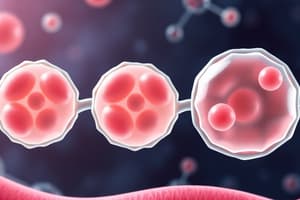Podcast
Questions and Answers
What is the primary function of carnitine acyltransferase I in the transport of fatty acids into mitochondria?
What is the primary function of carnitine acyltransferase I in the transport of fatty acids into mitochondria?
- To transfer the fatty acid group to carnitine, creating fatty acyl-carnitine (correct)
- To recreate fatty acyl-CoA from fatty acyl-carnitine
- To oxidize the β-carbon, producing a carbonyl group
- To facilitate the crossing of fatty acyl-carnitine into the inner mitochondrial membrane
What is the net result of one round of β-oxidation?
What is the net result of one round of β-oxidation?
- The production of acetyl-CoA and a fatty acyl-CoA that is 4 carbons shorter
- The production of acetyl-CoA and a fatty acyl-CoA that is 3 carbons shorter
- The production of acetyl-CoA and a fatty acyl-CoA that is 2 carbons shorter (correct)
- The production of acetyl-CoA and a fatty acyl-CoA that is 1 carbon shorter
What is the purpose of the translocase in the transport of fatty acids into mitochondria?
What is the purpose of the translocase in the transport of fatty acids into mitochondria?
- To oxidize the β-carbon, producing a carbonyl group
- To transfer the fatty acid group to carnitine, creating fatty acyl-carnitine
- To facilitate the crossing of fatty acyl-carnitine into the inner mitochondrial membrane (correct)
- To recreate fatty acyl-CoA from fatty acyl-carnitine
What is the function of carnitine acyltransferase II in the transport of fatty acids into mitochondria?
What is the function of carnitine acyltransferase II in the transport of fatty acids into mitochondria?
What is the name of the process by which fatty acids are broken down in the mitochondria?
What is the name of the process by which fatty acids are broken down in the mitochondria?
Why is the process of β-oxidation called as such?
Why is the process of β-oxidation called as such?
What is the primary function of adipose tissue lipase?
What is the primary function of adipose tissue lipase?
What is the purpose of the carnitine shuttle system?
What is the purpose of the carnitine shuttle system?
What is the end product of the β-oxidation pathway?
What is the end product of the β-oxidation pathway?
What is the significance of ketogenesis in starvation?
What is the significance of ketogenesis in starvation?
What is the role of cholesterol in the biological functions of lipids?
What is the role of cholesterol in the biological functions of lipids?
What is the function of arachidonic acid in the biological functions of lipids?
What is the function of arachidonic acid in the biological functions of lipids?
What is the primary function of triglycerides in the body?
What is the primary function of triglycerides in the body?
What is the role of fatty acids in the biological functions of lipids?
What is the role of fatty acids in the biological functions of lipids?
What is the approximate energy yield of 1 gram of fat?
What is the approximate energy yield of 1 gram of fat?
Which of the following is NOT a common fatty acid?
Which of the following is NOT a common fatty acid?
What is the byproduct of the breakdown of triglycerides in adipose tissue?
What is the byproduct of the breakdown of triglycerides in adipose tissue?
In which tissue is glycerol primarily taken up and converted to glucose?
In which tissue is glycerol primarily taken up and converted to glucose?
What is the primary function of the carnitine shuttle?
What is the primary function of the carnitine shuttle?
What is the net result of the beta-oxidation pathway?
What is the net result of the beta-oxidation pathway?
What is the byproduct of the activation of long-chain fatty acids?
What is the byproduct of the activation of long-chain fatty acids?
What is the function of CoA-SH in the activation of fatty acids?
What is the function of CoA-SH in the activation of fatty acids?
What is the primary advantage of storing energy as triglycerides?
What is the primary advantage of storing energy as triglycerides?
What is the role of lipase in the breakdown of triglycerides?
What is the role of lipase in the breakdown of triglycerides?
What is the result of Reaction 1 in the β-oxidation pathway?
What is the result of Reaction 1 in the β-oxidation pathway?
What is the purpose of the carnitine shuttle?
What is the purpose of the carnitine shuttle?
What is the ATP yield from the complete oxidation of a fatty acid with 16 carbon atoms?
What is the ATP yield from the complete oxidation of a fatty acid with 16 carbon atoms?
What is the end product of β-oxidation that enters the TCA cycle?
What is the end product of β-oxidation that enters the TCA cycle?
What is the purpose of the electron transport chain in β-oxidation?
What is the purpose of the electron transport chain in β-oxidation?
What is the fate of the last 3 carbons of an odd-numbered fatty acid?
What is the fate of the last 3 carbons of an odd-numbered fatty acid?
What is the purpose of the enzyme Propionyl-CoA-carboxylase?
What is the purpose of the enzyme Propionyl-CoA-carboxylase?
What is the condition under which ketogenesis occurs?
What is the condition under which ketogenesis occurs?
What is the result of Reaction 4 in the β-oxidation pathway?
What is the result of Reaction 4 in the β-oxidation pathway?
What is the purpose of the enzyme enoyl-CoA hydratase?
What is the purpose of the enzyme enoyl-CoA hydratase?
What is the primary destination of acetoacetate and β hydroxybutyrate released from the liver?
What is the primary destination of acetoacetate and β hydroxybutyrate released from the liver?
Why can't the liver utilize ketone bodies?
Why can't the liver utilize ketone bodies?
What is the primary source of energy for red blood cells?
What is the primary source of energy for red blood cells?
What is the fate of acetoacetate and β hydroxybutyrate in most tissue cells?
What is the fate of acetoacetate and β hydroxybutyrate in most tissue cells?
What is the role of ketone bodies in the brain?
What is the role of ketone bodies in the brain?
What is the fate of excess acetyl-CoA in the liver?
What is the fate of excess acetyl-CoA in the liver?
Which of the following tissues can utilize both fatty acids and ketone bodies for energy?
Which of the following tissues can utilize both fatty acids and ketone bodies for energy?
What is the primary reason why the brain cannot utilize fatty acids for energy?
What is the primary reason why the brain cannot utilize fatty acids for energy?
Flashcards are hidden until you start studying
Study Notes
Biological Functions of Lipids
- Components of cell membranes (phospholipids and cholesterol)
- Precursors of hormones (cholesterol and arachidonic acid)
- Long-term fuels (triglycerides)
Efficiency of Triglycerides as Fuel
- Compact storage: large fat droplets in adipose tissue cells
- Large body stores: 11 kg fat (as triglycerides) in a 70 kg adult
- Efficiency on weight basis: 1 g fat yields 38 kJ, compared to 1 g protein (21 kJ) and 1 g carbohydrate (17 kJ)
Structure of Triglyceride Fat
- Glycerol component of triacylglycerol
- Common fatty acids: palmitic acid (C16:0), stearic acid (C18:0), oleic acid (C18:1), and linoleic acid (C18:2)
Breakdown of Stored Triglyceride Fat in Adipose Tissue
- Lipase (activated by adrenaline and glucagon) breaks down triglyceride into fatty acids and glycerol
- Fatty acids travel in the plasma bound to albumin
- Glycerol diffuses into the bloodstream and is taken up by the liver for glycolysis
Metabolism of Glycerol
- Glycerol is water-soluble and taken up by all tissues
- In liver, glycerol enters glycolysis and is converted to pyruvate, then into the TCA cycle for oxidation
Fatty Acid Metabolism by β-Oxidation Pathway
- Occurs in the mitochondrial matrix
- Biological energy of fatty acid molecule is conserved as the transfer of 2 H atoms to the cofactors NAD+ and FAD
- Series of four enzyme reactions result in the removal of a 2-carbon unit as acetyl CoA
Activation of Long-Chain Fatty Acids
- Fatty acyl-CoA synthetase catalyzes the reaction between fatty acids and CoA
- Forms a thioester bond between the fatty acid and CoA
Transport of Fatty Acyl-CoA into Mitochondria: Carnitine Shuttle
- Fatty acyl-CoA is converted into fatty acyl-carnitine, which crosses the inner mitochondrial membrane via a translocase
- Carnitine is switched back for CoA by carnitine acyltransferase II
β-Oxidation Pathway
- Fatty acyl-CoA with 10 carbons undergoes β-oxidation
- One round of β-oxidation produces acetyl CoA and a fatty acyl-CoA that is 2 carbons shorter
- The process is energetically neutral
Regulation of Fat Metabolism
- Release of fatty acids from adipose tissue (adrenaline and glucagon activate lipase enzyme)
- Rate of entry into mitochondria via carnitine shuttle
- Rate of reoxidation of cofactors NADH and FADH2 by Electron Transport Chain
Metabolism of Odd-Numbered Fatty Acids
- β-Oxidation results in the production of propionyl-CoA
- Propionyl-CoA is converted into succinyl-CoA, which enters the TCA cycle
Ketone Body Formation
- Occurs when fat metabolism is the main source of energy (starvation, Type I diabetes)
- Fatty acid oxidation in hepatocytes leads to high concentrations of Acetyl CoA, which is converted into ketone bodies (acetoacetate and β-hydroxybutyrate) in the liver
- Ketone bodies can be utilized for energy by most tissues, but not the liver
Studying That Suits You
Use AI to generate personalized quizzes and flashcards to suit your learning preferences.




